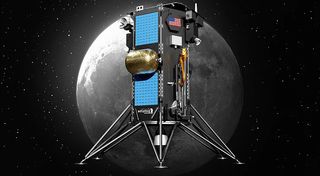NASA picks Intuitive Machines to land an ice-mining drill on the moon
The PRIME-1 mission launches in December 2022.

NASA has tapped the Houston-based company Intuitive Machines to land an ice-mining drill on the south pole of the moon in 2022.
Under the deal, NASA will pay Intuitive Machines $47 million to deliver the space agency's Polar Resources Ice Mining Experiment (PRIME-1) to the moon's south pole. It is the first-ever mission designed to harvest water ice from inside the moon, NASA officials said. Moon ice is a resource NASA hopes to exploit under its Artemis program, which aims to return astronauts to the moon in 2024.
"The information we’ll gain from PRIME-1 and other science instruments and technology demonstrations we're sending to the lunar surface will inform our Artemis missions with astronauts and help us better understand how we can build a sustainable lunar presence," Thomas Zurbuchen, NASA's associate administrator for science missions, said in an Oct. 16 statement.
Intuitive Machines will fly the 88-lb. (40 kilograms) PRIME-1 payload to the moon in December 2022 on its NOVA-C lander as part of NASA's Commercial Lunar Payload Services program, or CLPS. The company is one of several firms NASA has selected under CLPS to fly robotic missions to the moon.
"Laying the foundation to return humans to the moon is an incredible honor and even greater challenge," Intuitive Machines CEO Steve Altemus said in a separate statement. "At Intuitive Machines, we're hungry for the pursuit of these audacious missions that will redefine what a small business is capable of."
PRIME-1 will use its drill to dig about 3 feet (1 meter) below the lunar surface to search for buried water ice. The experiment includes a mass spectrometer to measure how much ice from PRIME-1's sample is lost from sublimation, the process in which a solid turns directly into vapor, which happens in space.
"PRIME-1 will give us tremendous insight into the resources at the moon and how to extract them," said Jim Reuter, NASA's associate administrator for space technology, in the NASA statement.
Get the Space.com Newsletter
Breaking space news, the latest updates on rocket launches, skywatching events and more!
A version of PRIME-1's lunar drill and mass spectrometer will be used on NASA's next robotic moon rover, called VIPER, which is planned to launch in 2023. That mission will also fly to the lunar south pole to search for water ice.
PRIME-1's flight won't be the first moon mission for Intuitive Machines.
Earlier this year, the company announced plans to launch its first Nova-C moon lander in 2021 to a region on the moon known as the "Ocean of Storms." That mission will land in Vallis Schröteri, the largest valley on the moon, and deliver five NASA experiments and some commercial payloads to the lunar surface under a $79.5 million contract with the U.S. space agency.
Email Tariq Malik at tmalik@space.com or follow him @tariqjmalik. Follow us @Spacedotcom, Facebook and Instagram.
Join our Space Forums to keep talking space on the latest missions, night sky and more! And if you have a news tip, correction or comment, let us know at: community@space.com.

Tariq is the Editor-in-Chief of Space.com and joined the team in 2001, first as an intern and staff writer, and later as an editor. He covers human spaceflight, exploration and space science, as well as skywatching and entertainment. He became Space.com's Managing Editor in 2009 and Editor-in-Chief in 2019. Before joining Space.com, Tariq was a staff reporter for The Los Angeles Times covering education and city beats in La Habra, Fullerton and Huntington Beach. In October 2022, Tariq received the Harry Kolcum Award for excellence in space reporting from the National Space Club Florida Committee. He is also an Eagle Scout (yes, he has the Space Exploration merit badge) and went to Space Camp four times as a kid and a fifth time as an adult. He has journalism degrees from the University of Southern California and New York University. You can find Tariq at Space.com and as the co-host to the This Week In Space podcast with space historian Rod Pyle on the TWiT network. To see his latest project, you can follow Tariq on Twitter @tariqjmalik.
